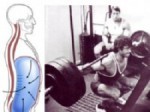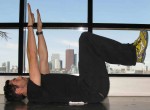By Dr. Chris Klachan, Chiropractor at Athlete’s Care at The Yorkville Club
Assistant Instructor, McMaster University Contemporary Acupuncture Program
What is the first thing that comes to mind when you think of training your core? Do you think of washboard abs brought out from under their cover by thousands of crunches?
One can think of the core as those muscles that contribute to spinal stability. The whole idea of core stability is protect the spine while loading and to allow maximum transfer of force from lower limbs to the upper limbs and vice versa.
Core, inside out
There is a lot more to the core than meets the eye, or rather, can be seen by the naked eye.
The diaphragm is typically thought of as a muscle that assists in respiration. During inhalation, the diaphragm contracts pushing down on the abdominal cavity and expanding the lung cavity, pulling air in.
The transversus abdominus lies deep to the oblique muscles on the sides and keeps abdominal cavity from expanding outward.
The pelvic floor is an intricate network of muscles. When activated they prevent the downward expansion of the abdominal cavity.
 Research has shown that milliseconds before a movement, healthy subjects will activate their diaphragm and transversus abdominus. When lifting a heavy object, one should brace like they are going to take a punch activating all of the above muscles. The effect is like squeezing a balloon in the abdomen, adding to spinal stability.
Research has shown that milliseconds before a movement, healthy subjects will activate their diaphragm and transversus abdominus. When lifting a heavy object, one should brace like they are going to take a punch activating all of the above muscles. The effect is like squeezing a balloon in the abdomen, adding to spinal stability.
The ability to consciously activate the internal stabilizers should be present to progressing to more advanced core stabilization exercises. The following progression can get you there:
Abdominal bracing: Lying on your back with your feet flat on the floor, place your index fingers lightly on the abdomen an inch to the inside of the hip bone. Brace like you are going to take a punch in the abdomen and you should feel the transversus abdominus rise into your fingers. Try to hold this for 5 to 10 seconds while breathing and repeat 10 times.
 Dead bug: Lying on your back with a small towel rolled up comfortably under the small of your back; bring your hands and knees straight up with your knees bent to 90 degrees. Start by bracing and maintaining consistent pressure of your low back on the towel.
Dead bug: Lying on your back with a small towel rolled up comfortably under the small of your back; bring your hands and knees straight up with your knees bent to 90 degrees. Start by bracing and maintaining consistent pressure of your low back on the towel.
 Progress to moving opposite arm and leg out, up to 10 times while keeping consistent pressure on the towel.
Progress to moving opposite arm and leg out, up to 10 times while keeping consistent pressure on the towel.
Core, outside in
Think of the spine as a tower and the muscles that support it, as ‘guy-wires.’ If one of these ‘guy-wires’ is excessively strong while another is weak, injury is likely. Recent research has shown that excessive volume of flexion exercises like crunches and twisting exercises may not be beneficial for some, especially those that have experienced disc injuries in the low back.
Isometric spinal loading is an effective way to train core strength and endurance without taking away from the movement capacity of the spine. Isometric simply means that load is put through the muscle without changing the length of it. Once internal core stabilization is mastered, one can progress to the following isometric core exercises:
 Front Plank: With your elbows directly under your shoulders create a bridge between the elbows and either your knees (easier) or toes (harder). Brace your core, squeeze your glutes and pull your shoulder blades into your back pockets. Start by holding for 20 seconds, progressing to 90 seconds without discomfort.
Front Plank: With your elbows directly under your shoulders create a bridge between the elbows and either your knees (easier) or toes (harder). Brace your core, squeeze your glutes and pull your shoulder blades into your back pockets. Start by holding for 20 seconds, progressing to 90 seconds without discomfort.
 Side Bridge: Again, with your elbow directly below your shoulder and either your down side knee (easier) or both feet (harder) in contact, pull hips off the floor to produce a straight line from your nose to between your knees. Start by holding for 20 seconds, progressing to 90 seconds without discomfort.
Side Bridge: Again, with your elbow directly below your shoulder and either your down side knee (easier) or both feet (harder) in contact, pull hips off the floor to produce a straight line from your nose to between your knees. Start by holding for 20 seconds, progressing to 90 seconds without discomfort.
 Glute Bridge: With your feet flat on the floor a couple inches apart, brace and squeeze your glutes to raise your hips to form a straight bridge from your shoulder blades to your knees. Hold for 5 seconds with each repetition for a total of 10-15 repetitions.
Glute Bridge: With your feet flat on the floor a couple inches apart, brace and squeeze your glutes to raise your hips to form a straight bridge from your shoulder blades to your knees. Hold for 5 seconds with each repetition for a total of 10-15 repetitions.
The exercises discussed here are just the tip of the iceberg. A large number of modifications exist that both increase and decrease the muscular load.


 Research has shown that milliseconds before a movement, healthy subjects will activate their diaphragm and transversus abdominus. When lifting a heavy object, one should brace like they are going to take a punch activating all of the above muscles. The effect is like squeezing a balloon in the abdomen, adding to spinal stability.
Research has shown that milliseconds before a movement, healthy subjects will activate their diaphragm and transversus abdominus. When lifting a heavy object, one should brace like they are going to take a punch activating all of the above muscles. The effect is like squeezing a balloon in the abdomen, adding to spinal stability. Dead bug: Lying on your back with a small towel rolled up comfortably under the small of your back; bring your hands and knees straight up with your knees bent to 90 degrees. Start by bracing and maintaining consistent pressure of your low back on the towel.
Dead bug: Lying on your back with a small towel rolled up comfortably under the small of your back; bring your hands and knees straight up with your knees bent to 90 degrees. Start by bracing and maintaining consistent pressure of your low back on the towel. Progress to moving opposite arm and leg out, up to 10 times while keeping consistent pressure on the towel.
Progress to moving opposite arm and leg out, up to 10 times while keeping consistent pressure on the towel. Front Plank: With your elbows directly under your shoulders create a bridge between the elbows and either your knees (easier) or toes (harder). Brace your core, squeeze your glutes and pull your shoulder blades into your back pockets. Start by holding for 20 seconds, progressing to 90 seconds without discomfort.
Front Plank: With your elbows directly under your shoulders create a bridge between the elbows and either your knees (easier) or toes (harder). Brace your core, squeeze your glutes and pull your shoulder blades into your back pockets. Start by holding for 20 seconds, progressing to 90 seconds without discomfort. Side Bridge: Again, with your elbow directly below your shoulder and either your down side knee (easier) or both feet (harder) in contact, pull hips off the floor to produce a straight line from your nose to between your knees. Start by holding for 20 seconds, progressing to 90 seconds without discomfort.
Side Bridge: Again, with your elbow directly below your shoulder and either your down side knee (easier) or both feet (harder) in contact, pull hips off the floor to produce a straight line from your nose to between your knees. Start by holding for 20 seconds, progressing to 90 seconds without discomfort. Glute Bridge: With your feet flat on the floor a couple inches apart, brace and squeeze your glutes to raise your hips to form a straight bridge from your shoulder blades to your knees. Hold for 5 seconds with each repetition for a total of 10-15 repetitions.
Glute Bridge: With your feet flat on the floor a couple inches apart, brace and squeeze your glutes to raise your hips to form a straight bridge from your shoulder blades to your knees. Hold for 5 seconds with each repetition for a total of 10-15 repetitions.










